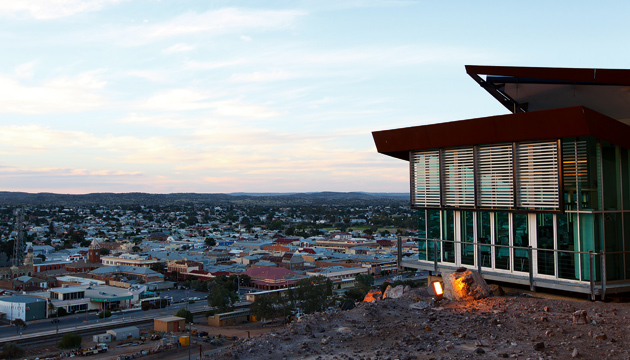This far western New South Wales town is forging a future from the remains of its past.
Story by John Dunn
The winds of change are blowing through Broken Hill, in the far west of New South Wales. This was a place with little going for it, according to explorer Charles Sturt as he made his way through the area in 1844. He noted a group of low hills with a break in them and so the site of the future city was named. He was not to know of the fortune they contained.
This was also a place damned by writer CJ Dennis, who visited in the early 1900s and began his ballad with:
Come sing us a song of the city of sand
Silver, sin and sixpenny ale
Dumped in a desolate, drought-struck land.
They were not to know that the site would become a wealthy town, renowned as having the biggest silver, lead and zinc deposit on earth, and home to the world’s largest mining company, Broken Hill Proprietary (BHP) Ltd. Those heady days are long gone and, with them, almost half the 1950s peak population of 33,000. But now a fresh breeze is blowing down streets named Cobalt, Crystal, Oxide and Sulphide, promising a born-again Broken Hill.
Last year the town became Australia’s first city to gain National Heritage listing. “This recognises the role the city and its mining operations have played in Australia’s development towards a modern and prosperous nation,” then Federal Environment Minister Greg Hunt said.
BHP Billiton – the company that was formed from the original company that unearthed the riches discovered in 1885 by boundary rider Charles Rasp – has donated $5.7 million towards revitalising the town. “We have not forgotten our rich history and connection with Broken Hill and are proud to help the city celebrate its past and prosper into the future,” CEO Andrew Mackenzie says. This grant, and solid backing from the local council, will provide the funds and the impetus for Broken Hill’s revival, principally through tourism.
“It is a major celebration for this city,” mayor Wincen Cuy says. “It will provide our community with the momentum it needs to go forward,” he says. “Our past is now our future. We have a wonderful story to tell the tourists we expect will come.”
The funding will be used to install infrastructure that aims, by 2020, to double annual visitor numbers from the present 150,000. A project entitled Living Museum and Perfect Light will make the most of the city’s heritage, such as its curiously contrasting Federation and Victorian architecture and its tiny corrugated iron workers’ cottages. “Streetscapes will reform the main streets, where there will be historic storyboards, art programs and entertainment, which will depict the unique inland character of our city,” says Andrea Roberts, the council’s manager for Economic Development and Culture.
The dominant Line of Lode, a 7.5-kilometre stretch of overburden extracted by past mining operations that marks the site of the original ore body and now forms an intimidating eastern barrier overlooking the city, will be mirrored to reflect colourful sunsets and the city skyline. An enlarged city square will showcase local minerals and oxides, and house events and festivals.
This story excerpt is from Issue #109
Outback Magazine: Oct/Nov 2016










